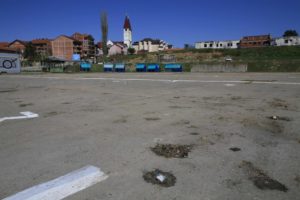Via International Human Rights Clinic
By Jared Small, J.D. ’18
Tomorrow, my Harvard Law School colleagues and I will board an airplane for Kosovo. Our goal: track down remnants of a war that ended nearly two decades ago.

Damage from depleted uranium penetrators in Gjakova/Đakovica. Credit: Naomi Toyoda / ICBUW
The Kosovo War ended in 1999 after a months-long NATO airstrike crippled Yugoslav and Serbian forces and paved the way for an internationally monitored Kosovan autonomy. Kosovo has since declared independence, and is moving forward towards what it hopes will become full membership in the European Union.
But there is an invisible part of this story that has largely escaped the public eye over the past decade and a half. Our team from the International Human Rights Clinic will travel to Kosovo to better understand potential environmental and human health impacts that linger from the war.
During the course of the NATO airstrikes, United States aircraft deployed at least 5,723 kg of Depleted Uranium (DU) ammunition at Serbian and Yugoslav targets. As an incredibly dense by-product of the process of enriching uranium, DU is often used by militaries in armor-piercing shells and bullets. American A-10 Thunderbolts fired DU at more than 100 ground targets during the campaign against Yugoslav President Slobodan Milosevic, who was attempting to cleanse Kosovo of its nearly 90% ethnic Albanian population.
In addition to penetrating armored vehicles, DU rounds ended up in areas now returned to civilian use, including bucolic buildings and urban streets. Even 18 years after the end of the war many of these penetrators remain scattered around Kosovo.
Filed in: Clinical Spotlight
Contact Office of Clinical and Pro Bono Programs
Website:
hls.harvard.edu/clinics
Email:
clinical@law.harvard.edu